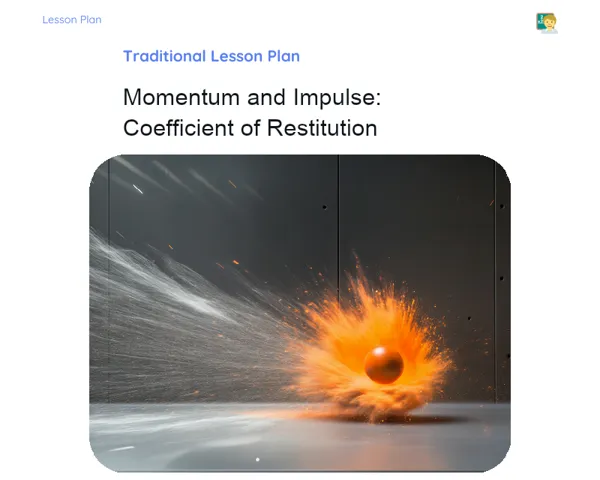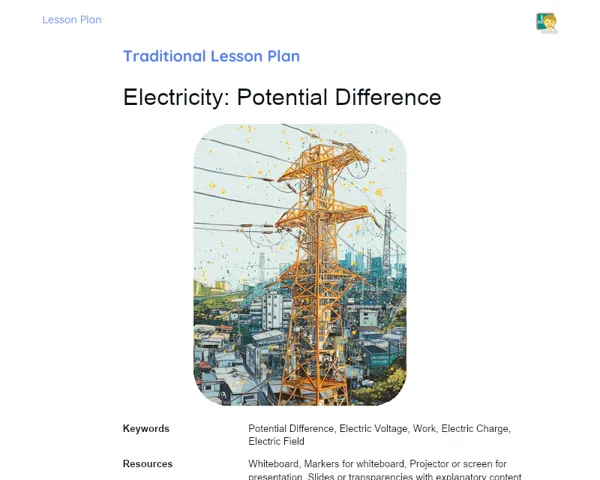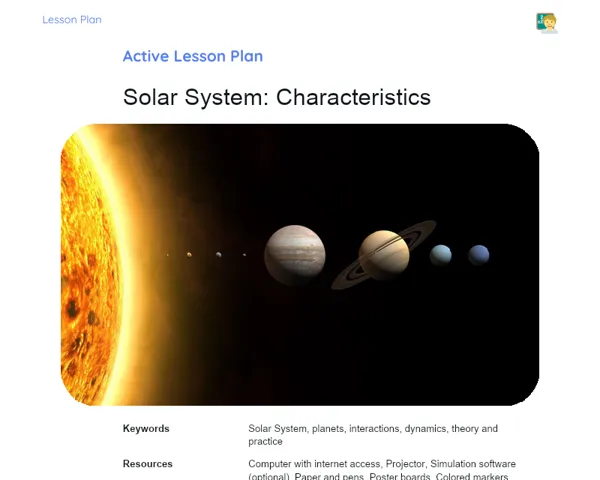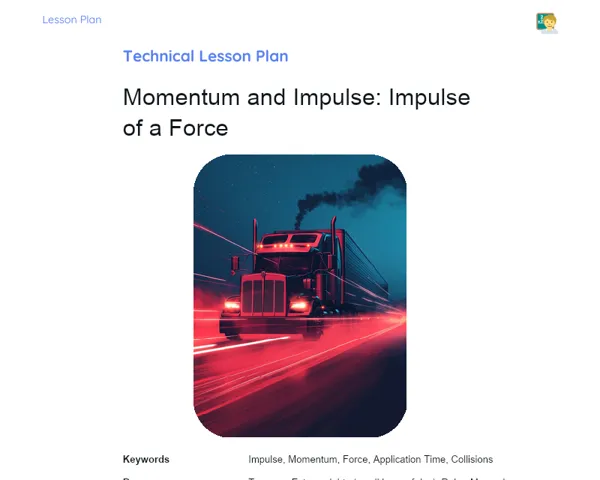Lesson Plan | Lesson Plan Tradisional | Momentum and Impulse: Momentum
| Keywords | Momentum, Linear Momentum, Formula Q = m * v, Mass, Velocity, Principle of Conservation, Collisions, Practical Examples, Solved Problems, Student Engagement |
| Resources | Whiteboard or chalkboard, Markers or chalk, Multimedia projector, Presentation slides, Notebooks, Calculators, Printed example problems, Diagrams and illustrations, Supplementary materials with theoretical content |
Objectives
Duration: (10 - 15 minutes)
This segment of the lesson plan is designed to familiarize students with the concept of momentum, discussing its relevance and real-life applications. By clearly outlining the objectives, students will comprehend what is expected of them and how to effectively apply these concepts to practical situations.
Objectives Utama:
1. Understand the concept of momentum and its significance in Physics.
2. Learn the formula Q = m*v and how to apply it in practical scenarios.
3. Develop skills to calculate the momentum of various objects based on their mass and velocity.
Introduction
Duration: (10 - 15 minutes)
This phase is intended to prepare students for the lesson's content, sparking interest and curiosity about the topic. By placing the concept of momentum in context and offering engaging examples, the teacher can capture students' attention from the outset, streamlining their comprehension of the material to be explored.
Did you know?
Did you know that momentum plays a critical role in understanding traffic accidents? Forensic experts often calculate the momentum of the involved vehicles to analyze the collision dynamics and establish liability. Moreover, in the realm of particle physics, momentum helps predict how subatomic particles, like protons and electrons, behave in particle accelerators.
Contextualization
To kick off the lesson on Momentum, position the students within the framework of Newton's laws and the conservation of energy. Explain that momentum is a crucial physical quantity that describes the motion of objects and is essential for grasping how bodies interact. Use relatable examples, like taxis speeding down the street, footballs being kicked, or even the orbits of planets, to illustrate the importance of this concept.
Concepts
Duration: (40 - 45 minutes)
This segment aims to provide students with a comprehensive understanding of momentum, its properties, and its practical uses. Through thorough explanations and real-world examples, students will master the formula Q = m * v across different contexts and solve related problems. The prepared questions will offer extra practice and reinforce the knowledge they've acquired.
Relevant Topics
1. Definition of Momentum: Explain that momentum (or linear momentum) is a vector quantity that measures the motion of an object. The formula is Q = m * v, where Q represents momentum, m is the mass of the object, and v is its velocity.
2. Properties of Momentum: Clarify that momentum is directly proportional to both the mass and velocity of an object. The larger the mass or velocity, the greater the momentum. Highlight that momentum, being a vector, has both direction and magnitude.
3. Principle of Conservation of Momentum: Explain that in a closed system (where no external forces are acting), the total momentum remains constant before and after an interaction. Use relatable scenarios like elastic and inelastic collisions to illustrate this principle.
4. Practical Applications: Provide tangible examples of momentum in action, such as in car collisions, sports (like the impact of a football), and in the field of particle physics. Utilize illustrations and diagrams to aid visual comprehension.
To Reinforce Learning
1. A car with a mass of 1200 kg is moving at a velocity of 20 m/s. What is the momentum of the car?
2. Two ice skaters, one weighing 50 kg and the other 70 kg, push off each other and glide away at speeds of 2 m/s and 1.5 m/s, respectively. Calculate the momentum of each skater and check the conservation of momentum.
3. A ball weighing 0.5 kg is kicked and achieves a speed of 10 m/s. What is the momentum of the ball? If the ball collides with another 0.5 kg ball at rest and both move together after colliding, what will be their speed post-collision?
Feedback
Duration: (20 - 25 minutes)
This part focuses on revising and solidifying the material covered in the lesson, ensuring students grasp the theoretical and practical applications of momentum. Discussing the questions resolved and engaging students with reflective queries fosters understanding, encourages active participation, and addresses any lingering doubts.
Diskusi Concepts
1. 🗣️ Discussion of Questions: 2. 1. Question 1: A car with a mass of 1200 kg is moving at a velocity of 20 m/s. What is the momentum of the car? 3. Answer: The momentum (Q) can be calculated using Q = m * v. Plugging in the values, Q = 1200 kg * 20 m/s = 24000 kg·m/s. Hence, the momentum of the car is 24000 kg·m/s. 4. 2. Question 2: Two ice skaters, one with a mass of 50 kg and the other with a mass of 70 kg, push off each other and move apart at speeds of 2 m/s and 1.5 m/s, respectively. Calculate the momentum of each skater and check if momentum is conserved. 5. Answer: The momentum of the 50 kg skater is Q1 = 50 kg * 2 m/s = 100 kg·m/s. The momentum of the 70 kg skater is Q2 = 70 kg * 1.5 m/s = 105 kg·m/s. Since they move in opposite directions, the total momentum is the vector sum: Q_total = 100 kg·m/s - 105 kg·m/s = -5 kg·m/s, confirming that momentum is conserved, as both started from rest (initial momentum = 0). 6. 3. Question 3: A ball weighing 0.5 kg is kicked and reaches a speed of 10 m/s. What is the momentum of the ball? If it collides with another ball of 0.5 kg at rest and they move together after the collision, what will be their speed afterwards? 7. Answer: The momentum of the ball is Q = 0.5 kg * 10 m/s = 5 kg·m/s. After the collision, both balls have a total mass of 1 kg. By conservation of momentum, 5 kg·m/s = 1 kg * v, where v is their speed after the collision. Therefore, v = 5 m/s.
Engaging Students
1. 🔍 Student Engagement: 2. 1. What role does momentum play in the analysis of collisions? 3. 2. How can we use the conservation of momentum to forecast the outcomes of a collision? 4. 3. Can you think of other real-life scenarios where momentum is significant? 5. 4. How does momentum tie into Newton's third law of motion (action and reaction)? 6. 5. If an object possesses a considerable amount of momentum, what can we infer about its mass and velocity?
Conclusion
Duration: (10 - 15 minutes)
This phase aims to review and consolidate the material covered in the lesson, ensuring students have grasped the primary concepts and their applications. By summarizing critical points, linking theory with practice, and emphasizing the topic's relevance, the teacher reinforces learning and prepares students for applying the concepts studied in future scenarios.
Summary
['Momentum, also termed linear momentum, is a vector quantity calculated via the formula Q = m * v, where Q stands for momentum, m for mass, and v for velocity.', 'Momentum directly correlates with both the mass and velocity of the object.', 'According to the principle of conservation of momentum, in a closed system, the total momentum prior to and following an interaction remains unchanged.', 'Momentum finds practical use in analyzing car collisions, sports like football, and in particle physics.']
Connection
The lesson bridged momentum theory with practice through commonplace examples and solved problems. Students could see how the formula Q = m * v applies to calculate momentum across various contexts, such as traffic incidents and sports, thus fostering an understanding of its significance and practical value.
Theme Relevance
The momentum concept is foundational for understanding numerous daily situations, such as investigating traffic accidents and the dynamics of moving objects. Being able to compute and utilize momentum aids in predicting and analyzing physical occurrences, rendering it an essential tool in physics and various applied domains, including engineering and forensic science.



